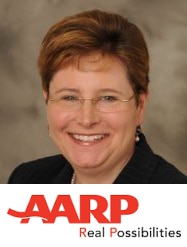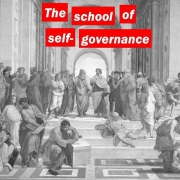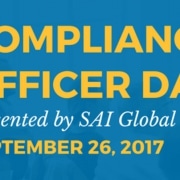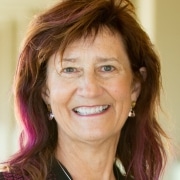Ethics and Compliance Trends: Interview with Ellen Hunt of AARP
Part of the mission of Ethical Systems is to enhance the work of practitioners and experts in the ethics and compliance field, as they are on the front lines of helping businesses transform their cultures and their employees act more ethically.
 In a recent interview with Ellen Hunt, Ethics & Compliance Program Director at AARP, she outlined current trends in the Ethics & Compliance (E&C) field as well as the most important steps businesses can take to encourage ethical behavior among organizations of all types and sizes. AARP is a nonprofit, nonpartisan organization, with a membership of nearly 38 million.
In a recent interview with Ellen Hunt, Ethics & Compliance Program Director at AARP, she outlined current trends in the Ethics & Compliance (E&C) field as well as the most important steps businesses can take to encourage ethical behavior among organizations of all types and sizes. AARP is a nonprofit, nonpartisan organization, with a membership of nearly 38 million.
How has the E&C field changed in recent years? Where is it going?
In the beginning, we needed to establish E&C as a profession so it can be recognized. Now, the field is maturing. With a little more than 20 years in, the E&C field has changed a lot and will continue to improve and evolve. I think we will see more integrated reporting at the Board level about how a company’s reputation for being ethical is tied to the bottom line, more integration of ethical standards into performance reviews and compensation decisions, Code of Conducts that are interactive and flexible rather than dictates, as well as a merging of enterprise risk management with compliance risk to drive the design and implementation of the Ethics & Compliance Program features and its activities.
Let’s talk about the difference between compliance and ethics. Do companies tend to focus on compliance, rather than ethics? What can companies do to get both?
Simply put, ‘compliance’ is about meeting legal requirements; every organization has to do this. ‘Ethics’ is about how you are going to do it and the right way to do it. This can vary somewhat by organization. As more and more evidence suggests that being ethical is connected to the bottom line not only in the ability to make money but to attract and retain talent and to survive an ethical scandal, I think that we will see organizations naturally shift from just complying with the law to behaving ethically.
At the end of the day, it is about human behavior. There will always be a few people who will break the law but—most people want to do the right thing most of the time. Sometimes they just don’t know how to do it. How the organization enforces and communicates policies—including when people do and do not follow them—raises an organization from one that complies with the law to one that behaves ethically.
How is AARP advancing adherence to compliance regulations and promoting ethics internally?
AARP is amazing in that it is committed to having a state of the art program even though it is not a highly regulated organization. The Board and C-suite are strong supporters of the program and have done a great job of not only setting the tone but leading by example. They have to be the messenger—since your leaders and managers will have more impact on their people than any E&C office will. We developed training around helping employees raise their concerns and have done coaching for managers on how to have an open door and encourage employees to come forward.
What are the conditions that tend to lead to an unethical culture?
Competing goals.
I think that people are naturally inclined to make the ethical choice but when that choice appears to compete with what others may want, the pressure is on. This is Asch’s experiment about conformity and how hard it is to be the only person staring at the front of the elevator when everyone else is facing the other way. Humans, like all other animals have a strong desire to be part of the herd. And as Asch and other events have shown us, we will do this even when it is not in our best interest.
This is why, to be effective, an Ethics & Compliance Program has to be focused on whether the organization is sending mixed messages. We have all been in a place where we know what the right thing to do is but doing it might have some costs in making our bosses or others unhappy. When given the choice between conflicting goals, people will often chose pleasing others.
What motivates organizational change? When do companies really commit to improving ethics?
When they see E&C as key to success and a competitive advantage. You can connect E&C to the bottom line in three ways:
- Reputation drives revenue. Organizations that have a reputation for being trustworthy do better. Warren Buffett is famously zealous about safeguarding reputation, which is a good indication of just how important reputation is for organizations.
- Attract and retain the best talent. Employees want to work for a company that has values—a place where they can believe in the mission. People have to have purpose.
- Resilience. An organization that has a reputation for being ethical is resilient in that it can survive an ethical scandal and maybe come out even better than before.
What are the most important ideas or principles [or top 3 steps] for improving ethics in an organization?
The first thing is that people need to understand what it is. You need to explain it in simple and practical terms. For example, I describe my job as that of helping the organization and each employee make better ethical decisions.
Collectively it is about “us” and we all have the same goals, that is, for the organization to be successful. I would advise to keep these ideas top of mind:
- You cannot be successful if you are unethical.
- Try not to be a police officer but a partner.
- Aim for more questions vs. concerns raised since if people ask questions before they move ahead with behaviors or decisions, it means they are thinking ethically.
So much of the role is about balance. How would you [or how should a leader] deal with an employee who is a top performer from a business perspective but a weaker performer on E&C matters?
You can’t be a top performer and be weak on E&C—they are mutually inclusive, or at least they should be. Sadly, this is not true in all organizations—particularly where making money is more important than ethical behavior (see recent Wall Street scandals). But no one should get a pass on ethical behavior because they are a star.
How can federal regulations make it easier for firms to develop effective E&C programs? Which federal guidelines do you think about? Which ones would you like to change, and how?
The best regulation is self-regulation. The Resource Guide to the U.S. Foreign Corrupt Practice Act by the Criminal Division of the U.S. Department of Justice and the Enforcement Division of the U.S. Securities and Exchange Commission did an outstanding job boiling down the three questions every organization needs to ask:
- Is the program well-designed? This means that the organization must take its specific business risks into account to determine how the E&C Program is designed and implemented.
- Is it fairly administered? The E&C Program MUST apply to everyone form the “boardroom to the mail room.”
- Does it work? Does the E&C Program contribute to the bottom line by enhancing reputation, retention and attraction rate, and increasing revenue?
I don’t really think that any regulations need to change but it would be very nice if the government would provide more information about how and when an effective ethics and compliance program has resulted in a decision not to prosecute and operated to reduce any fines or penalties. Because this information is generally not made public, with the exception of the Petersen case, it is difficult for the E&C profession to prove to its boards and shareholders how valuable it is, in the eyes of the regulators and law enforcement, to have an effective E&C program.
The goal of Ethical Systems is to make behavioral science research more useful to people like you. How can Ethical Systems be more helpful? Are there any areas where you wish there was more known about what works?
The Ethical Systems website has been incredibly valuable for research and videos. I recently used the videos for manager training on whistleblowers and I use the research studies for E&C messages. Where I think we can be more helpful is in more case studies, and focusing on how E&C professionals can become teachers themselves. The challenge for E&C professional is always how do you keep essentially the same message fresh?
What materials would you recommend to readers to learn more about your work?
- Modeling the Message: Communicating Compliance Through Organizational Values and Culture by Scott Killingsworth, 2012
- The ethical recovery paradox: how you handle an ethical situation will help you recover from a scandal and you may be better off afterwards.
- What Asch’s Line Experiment Can Teach Us about Conformity and In-House Lawyers
| Read additional blog entries and sign up for our newsletter. |









